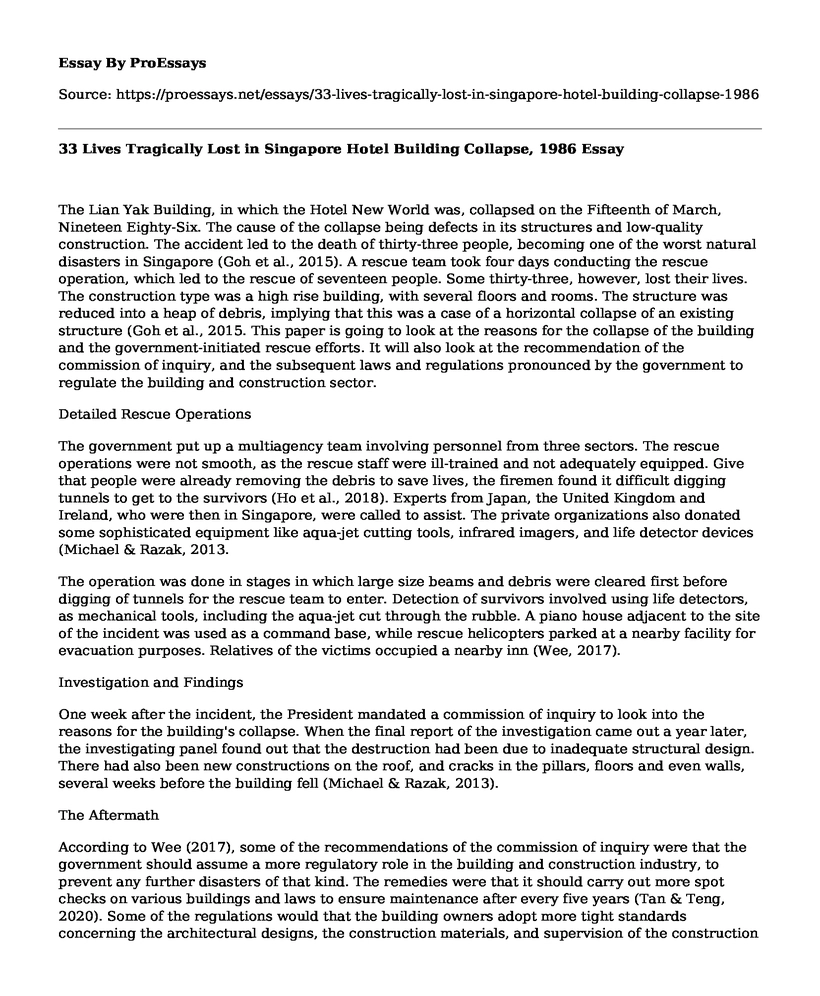The Lian Yak Building, in which the Hotel New World was, collapsed on the Fifteenth of March, Nineteen Eighty-Six. The cause of the collapse being defects in its structures and low-quality construction. The accident led to the death of thirty-three people, becoming one of the worst natural disasters in Singapore (Goh et al., 2015). A rescue team took four days conducting the rescue operation, which led to the rescue of seventeen people. Some thirty-three, however, lost their lives. The construction type was a high rise building, with several floors and rooms. The structure was reduced into a heap of debris, implying that this was a case of a horizontal collapse of an existing structure (Goh et al., 2015. This paper is going to look at the reasons for the collapse of the building and the government-initiated rescue efforts. It will also look at the recommendation of the commission of inquiry, and the subsequent laws and regulations pronounced by the government to regulate the building and construction sector.
Detailed Rescue Operations
The government put up a multiagency team involving personnel from three sectors. The rescue operations were not smooth, as the rescue staff were ill-trained and not adequately equipped. Give that people were already removing the debris to save lives, the firemen found it difficult digging tunnels to get to the survivors (Ho et al., 2018). Experts from Japan, the United Kingdom and Ireland, who were then in Singapore, were called to assist. The private organizations also donated some sophisticated equipment like aqua-jet cutting tools, infrared imagers, and life detector devices (Michael & Razak, 2013.
The operation was done in stages in which large size beams and debris were cleared first before digging of tunnels for the rescue team to enter. Detection of survivors involved using life detectors, as mechanical tools, including the aqua-jet cut through the rubble. A piano house adjacent to the site of the incident was used as a command base, while rescue helicopters parked at a nearby facility for evacuation purposes. Relatives of the victims occupied a nearby inn (Wee, 2017).
Investigation and Findings
One week after the incident, the President mandated a commission of inquiry to look into the reasons for the building's collapse. When the final report of the investigation came out a year later, the investigating panel found out that the destruction had been due to inadequate structural design. There had also been new constructions on the roof, and cracks in the pillars, floors and even walls, several weeks before the building fell (Michael & Razak, 2013).
The Aftermath
According to Wee (2017), some of the recommendations of the commission of inquiry were that the government should assume a more regulatory role in the building and construction industry, to prevent any further disasters of that kind. The remedies were that it should carry out more spot checks on various buildings and laws to ensure maintenance after every five years (Tan & Teng, 2020). Some of the regulations would that the building owners adopt more tight standards concerning the architectural designs, the construction materials, and supervision of the construction activities. The government went ahead and tasked an agency to conduct structural investigations on all recently built structures. It also combined the nation's fire and construction departments to streamline their operations. Lastly, all the buildings designed by the same architecture and constructed by the company was to conduct a check for any existing structural problems (Wee, 2017).
Conclusion
The collapse of the Hotel New World was a disaster of a very high magnitude. The incident revealed how much the Singaporean government was ill-prepared to handle such a tragedy. It also revealed the lack or the existence of weak regulatory rules in the building and construction department. The government officers also seemed to be lethargic in following up on such laws to help streamline the building sector. This unwelcome experience, however, presented the government, through the Singapore Civil Defence Force with a chance to re-look its rescue operations procedure, the suitability and level of their equipment. It also opened their eyes to the laxity in the implementation of the existing laws and regulations in the building and construction industry, and what amendments they needed to make to ensure smooth operation and safety of the sector going forward.
Reference
Goh, Y. M., Tan, S., & Lai, K. C. (2015). Learning from the Bhopal disaster to improve process safety management in Singapore. Process Safety and Environmental Protection, 97, 102-108.
https://www.sciencedirect.com/science/article/abs/pii/S0957582015000178Ho, E. Q. Y., Leong, C. H., & Lim, V. (2018). "Narratives of our past:" Taking a journey through history for collective wellbeing. Asian Journal of Social Psychology, 21(4), 271-281.
https://onlinelibrary.wiley.com/doi/full/10.1111/ajsp.12333Michael, A. O., & Razak, A. R. (2013). The study of claims arising from building collapses: case studies from Malaysia, Nigeria, Singapore and Thailand. Civil and Environmental Research, 3(11), 113-129.
HYPERLINK "https://s3.amazonaws.com/academia.edu.documents/44752780/8123-10215-1-PB.pdf?response-content-disposition=inline%3B%20filename%3DThe_Study_of_Claims_Arising_from_Buildin.pdf&X-Amz-Algorithm=AWS4-HMAC-SHA256&X-Amz-Credential=ASIATUSBJ6BADBLQZNN2%2F20200429%2Fus-east-1%2Fs3%2Faws4_request&X-Amz-Date=20200429T043051Z&X-Amz-Expires=3600&X-Amz-Security-Token=IQoJb3JpZ2luX2VjELj%2F%2F%2F%2F%2F%2F%2F%2F%2F%2FwEaCXVzLWVhc3QtMSJHMEUCIE65VrtR%2BWmQQHwsGbz8ME33%2F28JiULq%2Favhm4ndbK7jAiEAwm7krVag8Q28KqP11EecbUEMA8hVb3hg%2BC%2FE7w%2FhCpQqvQMI4f%2F%2F%2F%2F%2F%2F%2F%2F%2F%2FARAAGgwyNTAzMTg4MTEyMDAiDLrLvhl8SzC7sG5DJSqRA99JCVpVmwG96Wu9KpDfGbV6y3QpKc6zZ38BD4q0PPilvOiZGdoGfcXHaRq3yj9ye2ViXhwdxISfGubv4GtzbcU4IJb1jQuxNwK9EeUD5HHrv0u0xTNArYpOtftSvKpEtOnAB7dawjACB7oiXJ5QAd93ZIz9jFmmFlDbxmvhq9kdcWntoZ7pPdEl%2FdvXcNemATahC4yWYGC08GpJeEEbO5oNz20oVRQlZAr4p8LazVVR2hHKTDU0S1ppF82pLkJDcVd01b%2FAN4berUUm%2BFmxjLRR2lpoi0vOxUSglojcwmHiR9E2omoADE03sHbN1vRd20b8CtIE3L5wlaEPfUqSYXK5QrVYAqEmUkzhqEf%2Fh3aTreixkw31t%2FslrlJEFS0OelE84Tbe85RKYeYgv19H5uGRR%2Bw8s4dQsXcjNsPVfr0x%2BrjQzPmQ1H80oPNqj1XksNHXYjHP9UJIpDoXhwNYJYduUNlCTqZyH3cjuyqGfxknXJKz%2FHGcg7Zy2bV4Jyzf8HaPpmBLozltMzBL3N%2BbP9gxMN%2F5ovUFOusBpviHSef%2BNY%2Bz2N%2Fr0Z5QT6YJ06FcvXbXEBzqGAeBN6iewOKAKwjsDuqBWfZrb91DhMyo7ApCceIpraubnrx3%2B4H%2FUJVsUBh5nOjEVzjFUihQ1HPlMxvDdDveTJK7PrLOOPNsEMAT1MCworWQg7NSZNOOJVslDkvF0MpJbr5BjYancFLBkSgDm0SHGz1YvwGDN2GtSs9d1r7DN5bSy4S6G6EsQlKxOBODcd1p89xpebyla2EUa5%2FOk%2F8Lo5fS914shDwkabHeEZBNaiyS8h3gM5vVz9f%2F3HktO4SOaV2E9rmnHbKV7qriiQ87nw%3D%3D&X-Amz-SignedHeaders=host&X-Amz-Signature=6fcb5c92ee575e96dbd665ea818f2b965549fe0635fce3c6694c825aca445fa4" https://s3.amazonaws.com/academia.edu.documents/44752780/8123-10215-1-PB.pdf?response-content-disposition=inline%3B%20filename%3DThe_Study_of_Claims_Arising_from_Buildin.pdf&X-Amz-Algorithm=AWS4-HMAC-SHA256&X-Amz-Credential=ASIATUSBJ6BADBLQZNN2%2F20200429%2Fus-east-1%2Fs3%2Faws4_request&X-Amz-Date=20200429T043051Z&X-Amz-Expires=3600&X-Amz-Security-Token=IQoJb3JpZ2luX2VjELj%2F%2F%2F%2F%2F%2F%2F%2F%2F%2FwEaCXVzLWVhc3QtMSJHMEUCIE65VrtR%2BWmQQHwsGbz8ME33%2F28JiULq%2Favhm4ndbK7jAiEAwm7krVag8Q28KqP11EecbUEMA8hVb3hg%2BC%2FE7w%2FhCpQqvQMI4f%2F%2F%2F%2F%2F%2F%2F%2F%2F%2FARAAGgwyNTAzMTg4MTEyMDAiDLrLvhl8SzC7sG5DJSqRA99JCVpVmwG96Wu9KpDfGbV6y3QpKc6zZ38BD4q0PPilvOiZGdoGfcXHaRq3yj9ye2ViXhwdxISfGubv4GtzbcU4IJb1jQuxNwK9EeUD5HHrv0u0xTNArYpOtftSvKpEtOnAB7dawjACB7oiXJ5QAd93ZIz9jFmmFlDbxmvhq9kdcWntoZ7pPdEl%2FdvXcNemATahC4yWYGC08GpJeEEbO5oNz20oVRQlZAr4p8LazVVR2hHKTDU0S1ppF82pLkJDcVd01b%2FAN4berUUm%2BFmxjLRR2lpoi0vOxUSglojcwmHiR9E2omoADE03sHbN1vRd20b8CtIE3L5wlaEPfUqSYXK5QrVYAqEmUkzhqEf%2Fh3aTreixkw31t%2FslrlJEFS0OelE84Tbe85RKYeYgv19H5uGRR%2Bw8s4dQsXcjNsPVfr0x%2BrjQzPmQ1H80oPNqj1XksNHXYjHP9UJIpDoXhwNYJYduUNlCTqZyH3cjuyqGfxknXJKz%2FHGcg7Zy2bV4Jyzf8HaPpmBLozltMzBL3N%2BbP9gxMN%2F5ovUFOusBpviHSef%2BNY%2Bz2N%2Fr0Z5QT6YJ06FcvXbXEBzqGAeBN6iewOKAKwjsDuqBWfZrb91DhMyo7ApCceIpraubnrx3%2B4H%2FUJVsUBh5nOjEVzjFUihQ1HPlMxvDdDveTJK7PrLOOPNsEMAT1MCworWQg7NSZNOOJVslDkvF0MpJbr5BjYancFLBkSgDm0SHGz1YvwGDN2GtSs9d1r7DN5bSy4S6G6EsQlKxOBODcd1p89xpebyla2EUa5%2FOk%2F8Lo5fS914shDwkabHeEZBNaiyS8h3gM5vVz9f%2F3HktO4SOaV2E9rmnHbKV7qriiQ87nw%3D%3D&X-Amz-SignedHeaders=host&X-Amz-Signature=6fcb5c92ee575e96dbd665ea818f2b965549fe0635fce3c6694c825aca445fa4
Tan, D., & Teng, E. (2020). Fostering social cohesion in 21st century Singapore. In Building Resilient Neighbourhoods in Singapore (pp. 13-27). Springer, Singapore.
https://link.springer.com/chapter/10.1007/978-981-13-7048-9_2Wee, K. T. H. (2017). Exploring a New Approach to Business Continuity Management Training Practices by Singapore Hotels to Manage Terrorist Threats. Asian Journal of Public Affairs, 17-22.
file:///C:/Users/George%20Lango/Downloads/SSRN-id3021649.pdf
Cite this page
33 Lives Tragically Lost in Singapore Hotel Building Collapse, 1986. (2023, Jun 08). Retrieved from https://proessays.net/essays/33-lives-tragically-lost-in-singapore-hotel-building-collapse-1986
If you are the original author of this essay and no longer wish to have it published on the ProEssays website, please click below to request its removal:
- The Heart of Darkness Literary Analysis
- "The Yellow Paper" Theme of Freedom Essay
- Human Long Bone, Compact and Spongy Bone Paper Example
- Essay Sample on The Wrath of Achilles and its Role in the Iliad
- Essay Example on Kubla Khan: Poem as Social Criticism by Samuel Taylor Coleridge
- Research Paper on Bats & Viruses: The Spillover Effect & Coronavirus
- The Dual Nature of War and Love: Analyzing 'The Things They Carried' by Tim O'Brien - Free Essay







